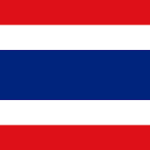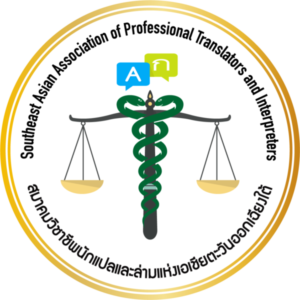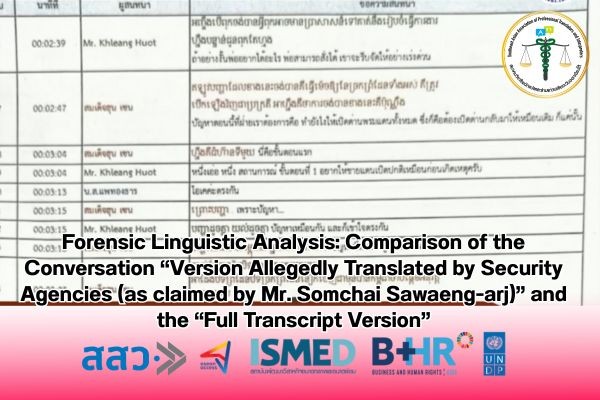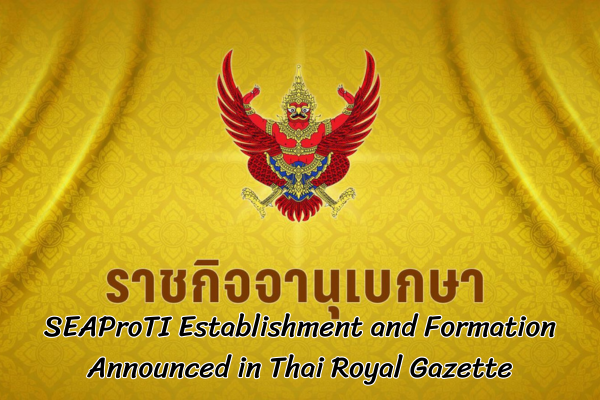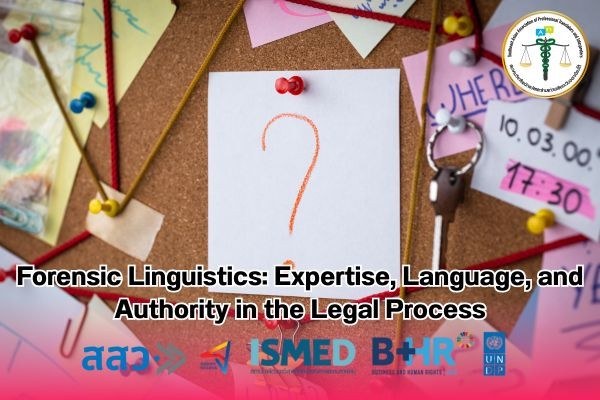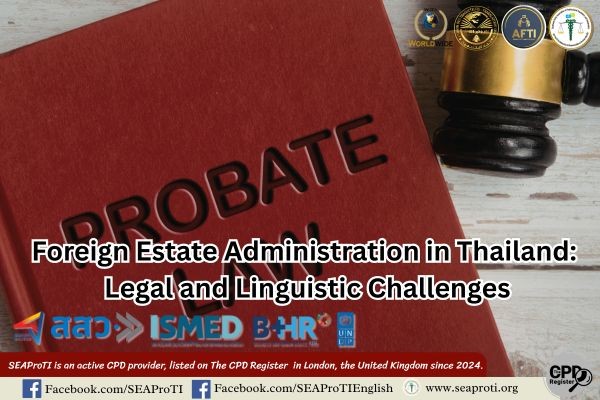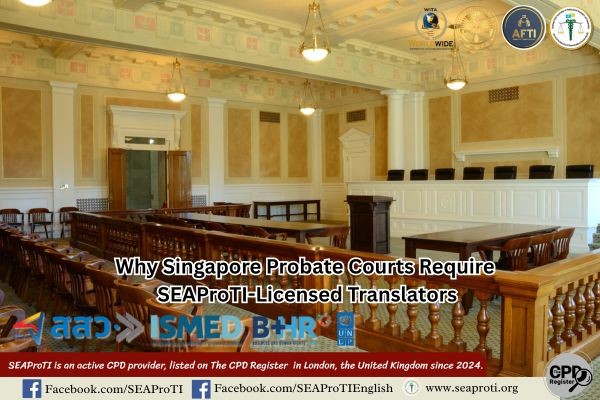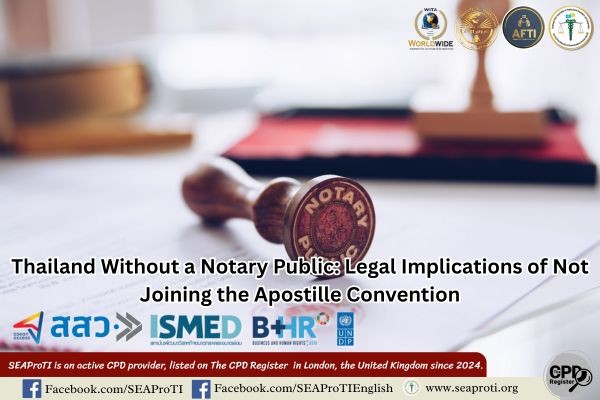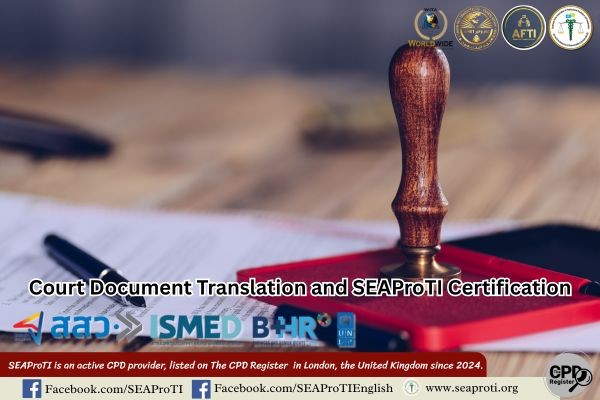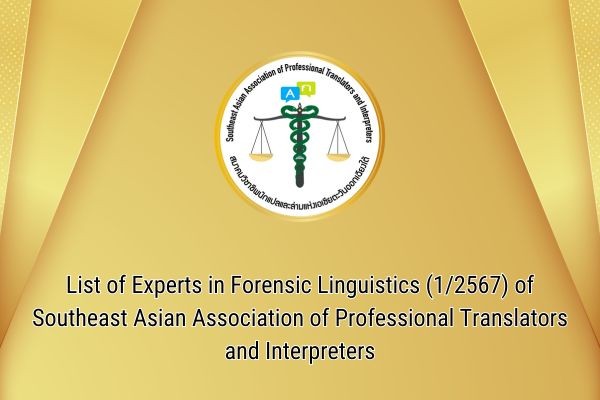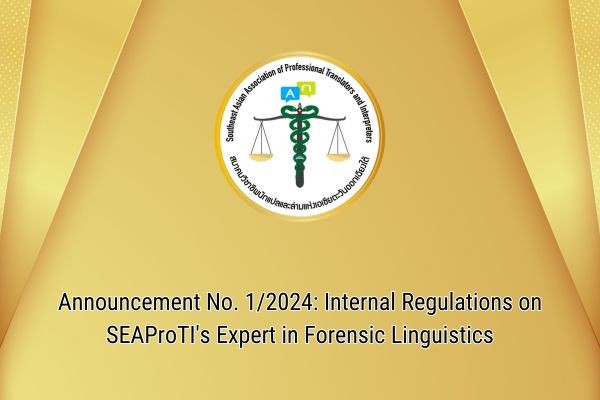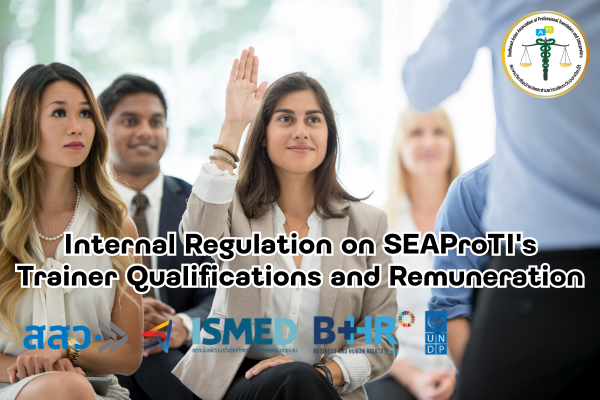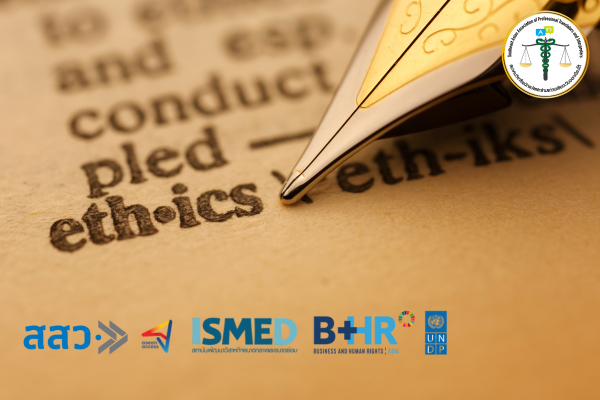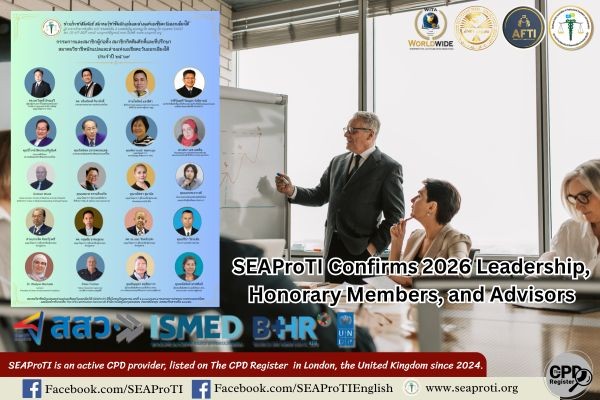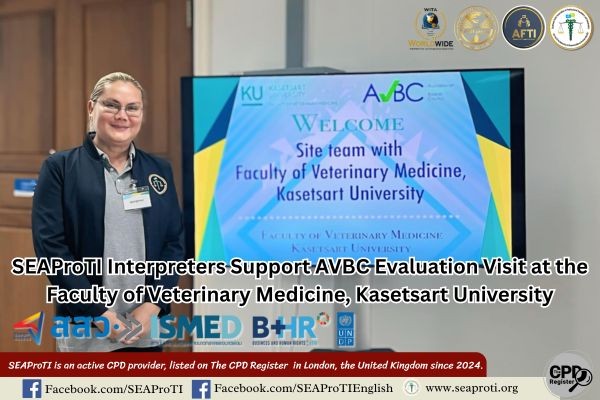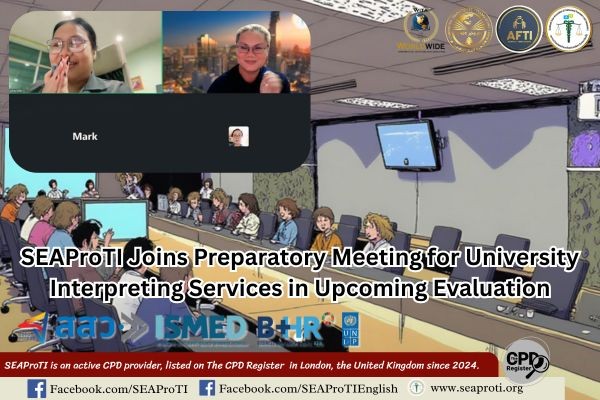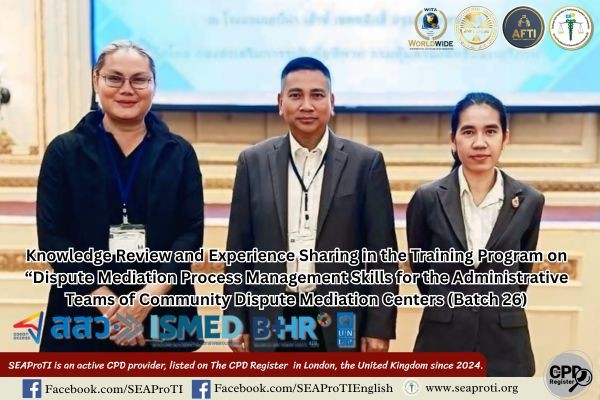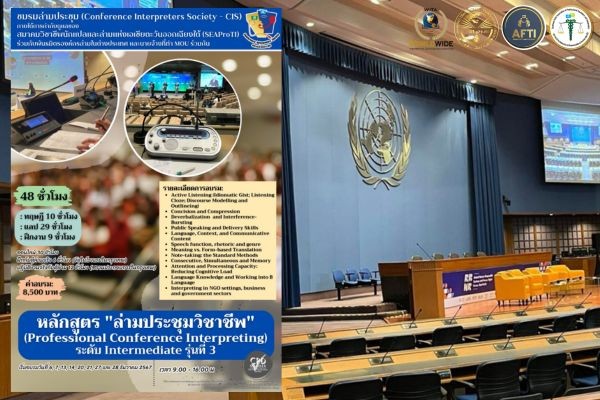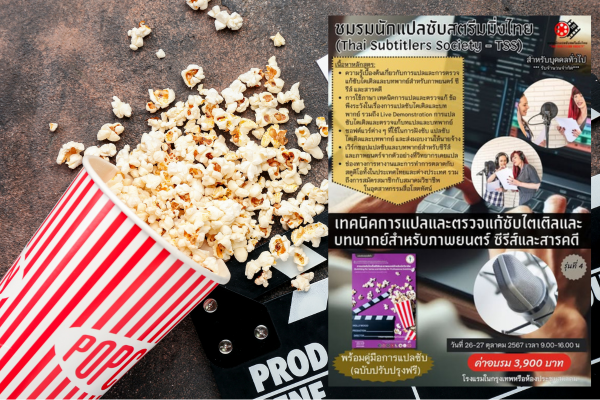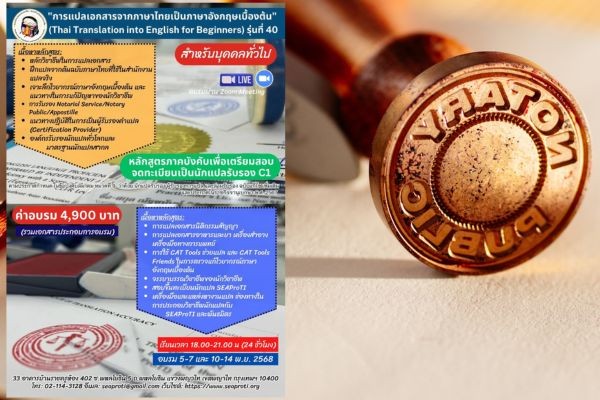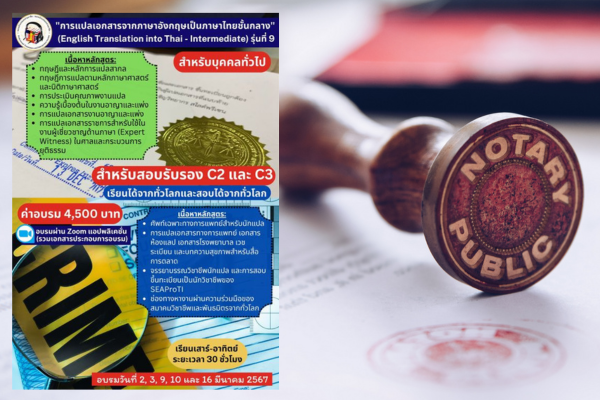Forensic Linguistic Analysis: Comparison of the Conversation “Version Allegedly Translated by Security Agencies (as claimed by Mr. Somchai Sawaeng-arj)” and the “Full Transcript Version”
23 August 2025, Bangkok – The release of a secret conversation tape between Ms. Paetongtarn Shinawatra, Prime Minister of Thailand, and Samdech Hun Sen, former Prime Minister of Cambodia, has sparked political and legal debate. The controversy escalated when Mr. Somchai Sawaeng-arj claimed that the tape had been “translated” by a state security agency, “certified” by police and military officials, and forwarded to the Constitutional Court.
This article analyzes the differences between the “translated version” disseminated by Mr. Somchai and the “full transcript version” using the framework of Forensic Linguistics to evaluate intention and political language choices.
Structural Comparison
Somchai’s Version (short, concise, politically framed):
- Removes minor details such as greetings, health inquiries, or laughter.
- Highlights that Paetongtarn prohibits Hun Sen from listening to the 2nd Army Region Commander and promises to “arrange” what Hun Sen wants.
- Uses a “direct-to-the-point” structure, creating the impression of a political bargain.
Full Transcript Version (long, diplomatic context):
- Presents a clear sequence: greeting → health discussion → border issue.
- Communication via interpreter (Mr. Huot), introducing layers of meaning and interpretation.
- Emphasizes the desire for peace and stability, and resolving border checkpoint closures.
Conclusion: SEAProTI’s full transcript and translation are more complete and reliable as legal evidence.
Accuracy of Meaning
Security Agency Version:
- Employs selective translation, emphasizing political weight.
- Terms like “enemy” or “I will arrange” remove polite or diplomatic tones.
- The conveyed meaning diverges from the speaker’s original intent.
SEAProTI Version:
Preserves diplomatic politeness strategies and intentions.
Example: apology for MFA spokesman’s remarks (retained by SEAProTI, omitted in Somchai’s version).
Conclusion: SEAProTI’s version more faithfully reflects speaker intent.
Neutrality & Credibility
Security Version:
Uses political framing, leaning toward “collusion narrative.”
Lacks professional neutrality.
SEAProTI Version:
- Follows verbatim transcription and translation standards.
- Includes original utterances, translations, and annotations.
Conclusion: SEAProTI’s transcript holds higher professional credibility and is more suitable for judicial use.
Translation Tools & Methods
- Security Version: likely uses summary translation → low legal quality.
- SEAProTI Version: employs forensic transcription & translation:
- transcription (verbatim),
- transliteration (romanization),
- translation (rendering into the target language).
Example of Forensic Linguistic Comparison
| Dimension | Original (Paetongtarn) | Translation (Mr. Huat) | Discrepancy |
|---|---|---|---|
| Addressee | “ท่าน” (formal, non-specific honorific) | “พ่อ” (familial, intimate) | Added kinship level → altered relational structure |
| Request/Command | Invitation: “บอกมาได้เลย” (you may tell me) | Command: “สามารถสั่งได้” (you can order) | Shift from offer → commanding right |
| Temporal Weight | “เดี๋ยวจะดูจัดการให้” (neutral, I will arrange it) | “รีบ…อย่างเร่งด่วน” (quickly, with urgency) | Added urgency absent in the original |
| Register | Polite, formal-casual | Authority-based | Changed tone and power dynamics |
Forensic Linguistic Analysis
Lexical Choice
Somchai’s version: harsher terms (“enemy,” “arrange for you,” “that commander wants to show off”) → portrays transactional, quid-pro-quo ties.
Full version: polite markers (“say,” “apologize,” “request understanding,” “seek peace”) → shows diplomatic register.
Pragmatics
Somchai’s version omits relational cues (laughter, “uncle/papa” kinship terms).
- Effect: artificially formalizes and intensifies tension.
- Full version: portrays friendly diplomatic negotiation, not conspiracy.
Narrative Framing
Somchai: frame = collusion narrative (secret deal with Cambodia).
Full transcript: frame = diplomatic coordination (resolving checkpoint closures, peace emphasis).
Translation Layer
Full version reveals interpreter’s role (Mr. Huot) → multi-layered interpretation.
Somchai’s version erases interpreter → gives false impression of direct speech.
Intention of Somchai’s Security Version
Forensic linguistic findings: Somchai’s “translation” is not verbatim, but selective and politically framed:
- Selective Omission: greetings, apologies, explanations removed.
- Amplification: “Do not listen to 2nd Army Region commander” exaggerated into disinformation.
- Political Framing: portrays Paetongtarn as secretly conspiring with Cambodia for personal gain.
- Conclusion: Somchai’s version serves as discursive evidence for political attack, not as a faithful transcript.
Final Conclusion
Forensic linguistics reveals stark contrasts between the two versions:
- Somchai’s version: politically dramatized, framed as collusion, omitting context.
- Full transcript: diplomatic language prioritizing peace and conflict resolution.
References
- Coulthard, M., & Johnson, A. (2017). An Introduction to Forensic Linguistics: Language in Evidence (2nd ed.). Routledge.
- Gibbons, J. (2003). Forensic Linguistics: An Introduction to Language in the Justice System. Blackwell.
- Olsson, J., & Luchjenbroers, J. (2014). Forensic Linguistics (2nd ed.). Bloomsbury.
- Fairclough, N. (1995). Critical Discourse Analysis: The Critical Study of Language. Longman.
- van Dijk, T. A. (2008). Discourse and Power. Palgrave Macmillan.
Verbatim Full Transcript
(telephone conversation verbatim transcript, complete version)
On Certified Translators, Translation Certification Providers, and Certified Interpreters of the Southeast Asian Association of Professional Translators and Interpreters (SEAProTI)
SEAProTI has announced qualifications and criteria for registered “Certified Translators,” “Translation Certification Providers,” and “Certified Interpreters” under Sections 9 and 10 of the Royal Gazette, Office of the Secretariat of the Cabinet, Prime Minister’s Office, Kingdom of Thailand, dated 25 July 2024, Volume 141, Part 66 Ng, p.100. Full text available at: นักแปลรับรอง ผู้รับรองการแปล และล่ามรับรอง
The Council of State proposed a Royal Decree stipulating that registered translators, including certification providers from professional associations or registered training institutions, may officially certify translations. (จดหมายถึงสมาคม SEAProTI ลงวันที่ 28 เม.ย. 2568)
SEAProTI is the first professional association in Thailand and Southeast Asia to establish a certification system for certified translators, certification providers, and certified interpreters.
Head Office: Baan Ratchakru Building, No. 33, Room 402, Soi Phaholyothin 5, Phaholyothin Road, Phayathai Subdistrict, Phayathai District, Bangkok 10400, Thailand
Email: hello@seaproti.com
Tel.: (+66) 2-114-3128 (Mon–Fri, 09:00–17:00 hrs)
บทวิเคราะห์เชิงนิติภาษาศาสตร์:
การเปรียบเทียบบทสนทนา “เวอร์ชันที่นายสมชาย แสวงการอ้างว่า แปลโดยฝ่ายความมั่นคง” และ “เวอร์ชันถอดเทปเต็ม”
23 สิงหาคม 2568, กรุงเทพมหานคร – การเผยแพร่เทปบทสนทนาลับระหว่าง นางสาวแพทองธาร ชินวัตร นายกรัฐมนตรีไทย และ สมเด็จฮุนเซน อดีตนายกรัฐมนตรีกัมพูชา เป็นประเด็นที่ก่อให้เกิดการถกเถียงทั้งทางการเมืองและกฎหมาย โดยเฉพาะอย่างยิ่งเมื่อ นายสมชาย แสวงการ อ้างว่ามีการแปลเอกสารจากเทปที่ถอดแล้วโดยหน่วยความมั่นคงของรัฐ และมีการ “รับรอง” โดยเจ้าหน้าที่ตำรวจและกองทัพ และเอกสารได้ถูกส่งต่อไปยังศาลรัฐธรรมนูญแล้ว บทความนี้มุ่งวิเคราะห์ความแตกต่างระหว่าง “เนื้อหาฉบับแปล” ที่นายสมชายเผยแพร่ กับ “เวอร์ชันถอดเทปเต็ม” โดยใช้กรอบ นิติภาษาศาสตร์ (Forensic Linguistics) เพื่อประเมินเจตนาและการใช้ถ้อยคำเชิงการเมือง
การเปรียบเทียบเชิงโครงสร้าง
1. เวอร์ชันสมชาย (สั้น กระชับ เน้นการเมือง):
- ตัดรายละเอียดปลีกย่อย เช่น คำทักทาย สุขภาพ การหัวเราะออกไป
- เน้นข้อความว่า แพทองธารห้ามฮุนเซนฟังแม่ทัพภาค 2 และ เสนอว่าจะจัดการสิ่งที่ฮุนเซนต้องการ
- ใช้โครงสร้าง “ตรงประเด็น” ที่อาจสร้างความเข้าใจว่าเป็นการ ต่อรองทางการเมือง
2. เวอร์ชันถอดเต็ม (ยาวและมีบริบททางการทูต):
- แสดงลำดับการสื่อสารชัดเจน: ทักทาย → พูดคุยสุขภาพ → เข้าสู่เรื่องชายแดน
- มีการใช้ล่าม (นายฮวด) แปลกลับไปกลับมา ทำให้เกิดชั้นของความหมายที่ต้องตีความ
- เน้นความประสงค์เรื่อง สันติภาพและเสถียรภาพ และการหาทางออกเรื่อง การปิด-เปิดด่านชายแดน
ข้อสรุป: ฉบับถอดเทปและแปลของ SEAProTI ดีกว่าในเชิงความครบถ้วนและเป็นพยานหลักฐานที่น่าเชื่อถือ
ความถูกต้องของความหมาย (Accuracy of Meaning)
เวอร์ชันความมั่นคง:
- มีลักษณะ selective translation คือเลือกคำที่ทำให้ข้อความมีน้ำหนักด้านการเมือง
- เช่น “ศัตรู” หรือ “จัดการให้” ซึ่งตัดทอนน้ำเสียงสุภาพและความละเอียดทางการทูตออกไป
- ความหมายที่สื่อออกมาอาจ ผิดเพี้ยนจากเจตนาต้นฉบับ
เวอร์ชัน SEAProTI:
- แสดงเจตนาของคู่สนทนาอย่างครบถ้วน รวมทั้งน้ำเสียงทางการทูต (politeness strategies)
- ยกตัวอย่าง: การขอโทษเรื่องคำพูดของโฆษก MFA ที่ SEAProTI เก็บไว้ แต่เวอร์ชันความมั่นคงละเว้น
ข้อสรุป: ฉบับถอดเทปและแปลของ SEAProTI สะท้อนเจตนาผู้พูดใกล้เคียงต้นฉบับมากกว่า
ความเป็นกลางและความน่าเชื่อถือ (Neutrality & Credibility)
เวอร์ชันความมั่นคง:
- เน้น framing ให้เป็นการ สมรู้ร่วมคิด → มีลักษณะ “political framing” มากกว่า “translation”
- ขาดการรักษาความเป็นกลางทางวิชาชีพ
เวอร์ชัน SEAProTI:
- ยึดหลัก “การถอดถ้อยคำตรงตัว” พร้อมแสดงชั้นการแปล (source–target)
- มีระบบคำอ่าน คำแปล และการอ้างอิงตามมาตรฐานการถอดเทปทางวิชาชีพ
ข้อสรุป: ฉบับถอดเทปและแปลของ SEAProTI มีมาตรฐานสูงกว่า และเหมาะสมที่จะใช้ในกระบวนการยุติธรรมมากกว่า
การใช้เครื่องมือแปล (Translation Tools & Methods)
เวอร์ชันความมั่นคง:
- อาจใช้เพียงการแปลสรุป (summary translation) → ลดทอนคุณภาพเมื่อใช้ในทางกฎหมาย
เวอร์ชัน SEAProTI:
ใช้วิธีการ forensic transcription & translation คือมีทั้ง transcription (ถอดเสียง), transliteration (คำอ่าน), และ translation (คำแปล) → สามชั้นหลักฐาน
ตังอย่างการเปรียบเทียบเชิงนิติภาษาศาสตร์
| มิติ | ต้นฉบับ (แพรทองธาร) | การแปล (นายฮวด) | ความคลาดเคลื่อน |
|---|---|---|---|
| ผู้รับสาร | “ท่าน” (สุภาพ, ไม่เจาะจง) | “พ่อ” (familial, intimate) | เพิ่มระดับ kinship → เปลี่ยนโครงสร้างความสัมพันธ์ |
| ลักษณะการขอ/สั่ง | เชิญชวน: “บอกมาได้เลย” | คำสั่ง: “สามารถสั่งได้” | จาก offer → commanding right |
| น้ำหนักเวลา | “เดี๋ยวจะดูจัดการให้” (neutral) | “รีบ…อย่างเร่งด่วน” | เพิ่ม urgency ที่ต้นฉบับไม่มี |
| register | สุภาพ, formal casual | authority-based | เปลี่ยนโทน |
หมายเหตุ: เทียบการแปลกับฉบับที่นายสมชาย แวงการนำมาใช้ในห้องพิจารณาคดี
การวิเคราะห์ด้วย Forensic Linguistics
Lexical Choice (การเลือกคำ)
- เวอร์ชันของคุณสมชาย: ใช้คำที่ “แรง” เช่น ศัตรู, แม่ทัพภาคคนนั้นอยากดูเท่, จะจัดการให้ → ชี้ไปที่ความสัมพันธ์แบบ ขอความช่วยเหลือ-ตอบแทน
- เวอร์ชันเต็ม: มีคำที่สะท้อนความสุภาพ เช่น บอกว่า, ขอโทษ, ขอให้เห็นใจ, ต้องการสันติภาพ → ชี้ไปที่การใช้ ภาษาการทูต
Pragmatics (บริบทการสื่อสาร)
- เวอร์ชันสมชาย ละเว้นบริบท เช่น การหัวเราะ การใช้คำว่า uncle/papa ที่แสดงความเป็นกันเอง → ทำให้บทสนทนาในเวอร์ชันสมชายถูก “ทำให้เป็นทางการและตึงเครียดกว่า”
- เวอร์ชันเต็มแสดงให้เห็นว่าเป็น การเจรจาเชิงมิตรภาพ มากกว่าการ “สมคบคิด”
Narrative Framing (การจัดกรอบเรื่อง)
- เวอร์ชันสมชาย → กรอบการสมรู้ร่วมคิด: ผู้นำไทยขอให้ผู้นำกัมพูชาไม่ฟังฝ่ายตรงข้าม พร้อมเสนอสิ่งตอบแทน
- เวอร์ชันเต็ม → กรอบการประสานท่าทีทางการทูต: เน้นการแก้ปัญหาการปิดด่านและยืนยันสันติภาพ
Translation Layer (ชั้นการแปล)
- ในเวอร์ชันเต็ม เห็นชัดว่ามีการสื่อสารผ่านล่าม (นายฮวด) → ทำให้เกิดความเป็นไปได้ในการ ตีความ/เลือกถ้อยคำแตกต่างกัน
- เวอร์ชันสมชาย “ลบ” บทบาทล่ามออกไป ทำให้ดูเหมือนคำพูดเป็น เจตนาตรงของแพทองธาร ทั้งหมด
เจตนาของเอกสารแปลในเวอร์ชันที่นายสมชาย แสวงการนำมา
จากการวิเคราะห์เชิงนิติภาษาศาสตร์ พบว่าเวอร์ชันสมชาย ไม่ใช่การถอดเทปตรงตัว แต่เป็น การคัดเลือกและย่อ โดยมีลักษณะดังนี้
- Selective Omission (ตัดตอน): ตัดทักทาย ขอโทษ หรือการพูดเชิงอธิบายออก เหลือแต่ประโยคที่สื่อความเป็น “ข้อตกลงลับ”
- Amplification (ขยายความ): เพิ่มน้ำหนักในบางจุด เช่น ไม่ให้ฟังแม่ทัพภาค 2 → สื่อว่าเป็น การบิดเบือนข้อมูล
- Political Framing: ทำให้ดูเหมือนการสมคบกับกัมพูชาเพื่อผลประโยชน์ส่วนตน มากกว่าการเจรจาในฐานะผู้นำรัฐบาล
ดังนั้น เจตนาของเวอร์ชันสมชายคือ การสร้าง “พยานหลักฐานเชิงวาทกรรม” ที่ใช้โจมตีทางการเมือง โดย framing ให้นายกรัฐมนตรีไทยปรากฏในฐานะ ผู้นำที่ต่อรองกับต่างชาติหลังฉาก ซึ่งต่างจากเจตนารมณ์ของบทสนทนาในเวอร์ชันเต็มที่เน้น สันติภาพและการแก้ปัญหาชายแดน
บทสรุป
การวิเคราะห์ด้วยนิติภาษาศาสตร์แสดงให้เห็นว่า เวอร์ชันสมชาย และ เวอร์ชันถอดเทปเต็ม มีความแตกต่างกันทั้งในระดับคำ บริบท และกรอบเรื่อง โดยเวอร์ชันสมชายถูก “ทำให้เข้มข้นทางการเมือง” ผ่านการเลือกถ้อยคำและการละเว้นบริบท ซึ่งบ่งชี้เจตนาที่จะสร้างการรับรู้ว่ามีการสมคบคิด ขณะที่เวอร์ชันเต็มสะท้อนการใช้ ภาษาเชิงการทูต ที่มุ่งลดความขัดแย้งและหาทางออก
เอกสารอ้างอิง
- Coulthard, M., & Johnson, A. (2017). An Introduction to Forensic Linguistics: Language in Evidence (2nd ed.). Routledge.
- Gibbons, J. (2003). Forensic Linguistics: An Introduction to Language in the Justice System. Blackwell.
- Olsson, J., & Luchjenbroers, J. (2014). Forensic Linguistics (2nd ed.). Bloomsbury.
- Fairclough, N. (1995). Critical Discourse Analysis: The Critical Study of Language. Longman.
- van Dijk, T. A. (2008). Discourse and Power. Palgrave Macmillan.
- ถอดความจากเสียงสนทนาทางโทรศัพท์แบบ Verbatim ฉบับสมบูรณ์
เกี่ยวกับนักแปลรับรอง ผู้รับรองการแปล และล่ามรับรองของสมาคมวิชาชีพนักแปลและล่ามแห่งเอเชียตะวันออกเฉียงใต้
* สมาคมวิชาชีพนักแปลและล่ามแห่งเอเชียตะวันออกเฉียงใต้ (SEAProTI) ได้ประกาศหลักเกณฑ์และคุณสมบัติผู้ที่ขึ้นทะเบียนเป็น “นักแปลรับรอง (Certified Translators) และผู้รับรองการแปล (Translation Certification Providers) และล่ามรับรอง (Certified Interpreters)” ของสมาคม หมวดที่ 9 และหมวดที่ 10 ในราชกิจจานุเบกษา ของสำนักเลขาธิการคณะรัฐมนตรี ในสำนักนายกรัฐมนตรี แห่งราชอาณาจักรไทย ลงวันที่ 25 ก.ค. 2567 เล่มที่ 141 ตอนที่ 66 ง หน้า 100 อ่านฉบับเต็มได้ที่: นักแปลรับรอง ผู้รับรองการแปล และล่ามรับรอง
** สำนักคณะกรรมการกฤษฎีกาเสนอให้ตราเป็นพระราชกฤษฎีกา โดยกำหนดให้นักแปลที่ขึ้นทะเบียน รวมถึงผู้รับรองการแปลจากสมาคมวิชาชีพหรือสถาบันสอนภาษาที่มีการอบรมและขึ้นทะเบียน สามารถรับรองคำแปลได้ (จดหมายถึงสมาคม SEAProTI ลงวันที่ 28 เม.ย. 2568)
*** สมาคมวิชาชีพนักแปลและล่ามแห่งเอเชียตะวันออกเฉียงใต้ เป็นสมาคมวิชาชีพแห่งแรกในประเทศไทยและภูมิภาคเอเชียตะวันออกเฉียงใต้ที่มีระบบรับรองนักแปลรับรอง ผู้รับรองการแปล และล่ามรับรอง
สำนักงานใหญ่: อาคารบ้านราชครู เลขที่ 33 ห้อง 402 ซอยพหลโยธิน 5 ถนนพหลโยธิน แขวงพญาไท เขตพญาไท กรุงเทพมหานคร 10400 ประเทศไทย
อีเมล: hello@seaproti.com
โทรศัพท์: (+66) 2-114-3128 (เวลาทำการ: วันจันทร์–วันศุกร์ เวลา 09.00–17.00 น.)
